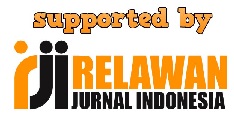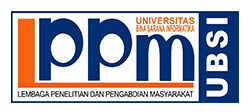EFL Learners’ Feedback on The Use of Short Movies in English Speaking Classroom
Abstract
Abstract –Current investigation was intended to see the feedback of EFL learners on the application of short movies in English speaking classroom. Experimental research design was consciously chosen which primarily concerned on descriptive statistical analysis. Fourteen sample was taken purposefully. To measure the EFL learners’ feedback, distribution of questionnaire items set was utilized. Twenty one items were designed to seek the aspects of psychological, linguistics, and literature. The findings revealed that positive feedback were made by the participants viewed from psychological viewpoint (English learning preference, motivation, enthusiasm, and bravery). In addition, positive feedback were also earned by majority of the EFL learners on their English speaking aspects seen from linguistics viewpoint (pronunciation, vocabulary, content, grammar, and fluency), excluding intonation. Besides, positive feedback were possessed by some other EFL learners concerned on literature viewpoint (generating moral lesson, understanding sequence of movie events, speaking and writing, as well as analyzing movie event), excluding story plot. Some following parties limited to English lecturers, EFL students, stakeholders, and other researchers were offered several pedagogical implication.
Full Text:
PDFReferences
Abolfotouh, M. M. (2020). The effect of a proposed program based on animated films to develop English majors non-verbal skills in light of the communicative approach. Journal of Scientific Research in Education: Ain Shams University, 21, 367–387. 10.21608/JSRE.2020.107554
Adillatunnisa’, Masrul,& Asilestari, P.,. (2021). The effect of short movie toward students’ speaking skill. Journal of English Language and Education, 6(2), 39–49. https://doi.org/10.31004/jele.v%vi%i.140
Al Murshidi (2020). Effectiveness of movies in teaching and learning English as a Foreign Language at universities in UAE. Psychology and Education, 57(6), 442-450. https://doi.org/10.17762/pae.v57i6.50
Andas, N. H. (2020). Students’ speaking problem at the fourth semester of English study program in Sembilanbelas November Kolaka. ELT Worldwide: Journal of English Language Teaching, 7(1), 1. https://doi.org/10.26858/eltww.v7i1.12359
Ainy, Q., & Pratama, H. (2020). Teacher social competence, student learning motivation, and learning outcomes in English subject. ELT Forum: Journal of English Language Teaching, 9(1), 27–37. https://doi.org/10.15294/elt.v9i1.38131
Astuti, P., & Lammers, J. C. (2017). Making EFL instruction more CLT-oriented through individual accountability in cooperative learning. TEFLIN Journal - A Publication on the Teaching and Learning of English, 28(2), 236. https://doi.org/10.15639/teflinjournal.v28i2/236-259
Bambini, V., Van Looy, L., Demiddele, K., & Schaeken, W. (2021). What is the contribution of executive functions to communicative-pragmatic skills? Insights from aging and different types of pragmatic inference. Cognitive Processing, 22(3), 435–452. 10.1007/s10339-021-01021-w
Basri, M. (2019). Faktor kecemasan siswa dalam berbicara bahasa Inggris pada mahasiswa Universitas Ahmad Dahlan Yogyakarta. Jurnal Mitra Pendidikan, 3(11), 1419–1427.
Bernardi, J., & Ogawa, S. T. (2021). Routledge handbook of Japanese cinema. Routledge.
Dalem, M. (2017). Difficulties of speaking that are encountered by English language students at Al Margeb University. Premise Journal of Education, 6(2), 20–29. Retrieved from http://dx.doi.org/10.24127/pj.v6i2.1002
ElQersh, A. F. B. A. (2023). An enrichment program based on authentic learning approach to enhance EFL listening. , العلوم التربوية , 31(3) , 37 – 80. 10.21608/ssj.2023.344575
Goctu, R. (2017). Using movies in EFL classrooms. European Journal of Language and Literature Studies, 3(2), 121–124. https://doi.org/10.26417/ejls.v8i1.p121-124
Halawa, V. P. A., Sihombing, M. I., & Nasution, F. T. Z. (2022). The influence of English movie in improving students’ speaking skill. Review of Multidisciplinary Education, Culture and Pedagogy, 1(2), 49–58. 10.55047/romeo.v1i2.92
Hameed, P. F. M. (2016). Short films in the EFL classroom: Creating resources for teachers and learners. International Journal of Applied Linguistics and English Literature, 5(2), 215–219. https://doi.org/10.7575/aiac.ijalel.v.5n.2p.215
Iman, J. N (2017). Debate Instruction in EFL Classroom: Impacts on the critical thinking and speaking skill. International Journal of Instruction, 10(4), 87-108. https://doi.org/10.12973/iji.2017.1046a
Irfani, B., Meisuri, M., & Rohmatillah, R. (2018). Speaking performance of Islamic boarding school and public school-based graduates: A comparative study. JEELS (Journal of English Education and Linguistics Studies), 5(1), 97-113. https://doi.org/10.30762/jeels.v5i1.558.
Irmanda, I., Ahmad, Y. B., & al Baekani, A. K. (2021). Students’ perspectives towards English short movies as media to assist their vocabulary mastery in online learning. Edukatif: Jurnal Ilmu Pendidikan, 3(4), 2081–2091. https://doi.org/10.31004/edukatif.v3i4.1151
Islam, W., Ahmad, S., & Islam, Md. D. (2022). Investigating the problems faced by the university EFL learners in speaking English language. International Journal of TESOL & Education, 2(2), 47–65. https://doi.org/10.54855/ijte.22223.
Karataş, T. Ö., & Tuncer, H. (2020). Sustaining language skills development of pre-service EFL teachers despite the COVID-19 interruption: A case of emergency distance education. Sustainability, 12(19), 8188. https://doi.org/10.3390/su12198188
Khapsoh, S. (2020). Students’ psychological speaking problems at the eleventh grade of linguistic major of Senior High School 2 Purwokerto, Banyumas Regency. Repository IAIN Purwokerto.
Kim, D. (2020). Learning language, learning culture: Teaching language to the whole student. ECNU Review of Education, 3(3), 519–541. https://doi.org/10.1177/2096531120936693
Kristiawan, D., Ferdiansyah, S., & Picard, M. (2022). Promoting vocabulary building, learning motivation, and cultural identity representation through digital storytelling for young Indonesian learners of English as a Foreign Language. Iranian Journal of Language Teaching Research, 10(1), 19–36. 10.30466/ijltr.2022.121120
Kohar, D. (2022). Measuring the effectiveness of the brain-based learning model on the level of reading comprehension based on exposition reading structures in Junior High School. Educational Sciences: Theory & Practice, 22(1), 78-89. 10.12738/jestp.2022.1.0007
Liando, Nihta & Sahetapy, Ray & Maru, Mister. (2018). English major students’ perceptions towards watching English movies in listening and speaking skills development. Advances in Social Sciences Research Journal. 5(6), 1-16. 10.14738/assrj.56.4627.
Madiyoh, R., Hidayanto, N., & Putro, P. S. (2018). The effectiveness of authentic short movies in enhancing students speaking skill. International Journal of English Literature and Culture, 6(3), 44–49. https://doi.org/10.14662/IJELC2018.030
Nurfauziah, D. H., Aflahah, N. A., Riskina, A., Dayanti, G. R., Yansyah, Y., Kurniawan, D., & Dharojah, R. W. (2023). The use of English subtitle on films to help self-study in mastering vocabulary. Jurnal Keilmuan Dan Keislaman, 2(1), 35–42. 10.23917/jkk.v2i1.54
Nyström, K. (2019). Film as a Tool in English Teaching : A Literature Review on the use of Film to develop Students’ linguistic Skills and critical Thinking in Upper Secondary EFL Classrooms (Dissertation). Retrieved from https://urn.kb.se/resolve?urn=urn:nbn:se:du-30811
Oflaz, A. (2019). The effects of anxiety, shyness and language learning strategies on speaking skills and academic achievement. European Journal of Educational Research, 8(4), 999–1011. https://doi.org/10.12973/eu-jer.8.4.999
Pratiwi, T. L. (2021). EFL college students writing anxiety of English language education at Universitas Internasional Batam. ELT Forum: Journal of English Language Teaching, 10(2), 100–112. https://doi.org/10.15294/elt.v10i2.42908
Perez, M. M. (2022). Second or foreign language learning through watching audio-visual input and the role of on-screen text. Language Teaching, 55(2), 163–192. https://doi.org/10.1017/S0261444821000501
Roslim, N., Azizul, A. F., Nimehchisalem, V., & Abdullah, M. H. T. (2021). Exploring movies for language teaching and learning at the tertiary level. Asian Journal of University Education (AJUE), 17(3), 271–280. 10.24191/ajue.v17i3.14520
Rumiyati, R., & Seftika, S. (2018). Anxiety of speaking English in English foreign language (EFL) class. Journal of English Education, Literature and Linguistics, 1(1), 276591. Retrieved from https://ojs.stkippgri-lubuklinggau.ac.id/index.php/JEELL/article/view/37
Sokip. (2020). Overcoming the problem of learning foreign language skills in the classroom. Universal Journal of Educational Research, 8(2), 723-729. https://doi.org/doi:10.13189/ujer.2020.080246
Souisa, T. R. (2020). Study on speaking problems and psychological factors encountered by students in developing their speaking skill at SMA Kristen Dobo, Aru District. International Journal of Language Education, 1(1), 9–21. https://doi.org/10.30598/matail.v1i1.2769
Tnomat, Densiana., Billik, M. O., & Banu, T. B. J. (2022). The implementation of short English movie to improve students’ vocabulary mastery in interpretive listening class. Saga: Journal of English Language Teaching and Applied Linguistics, 3(1), 59–68. https://doi.org/10.21460/saga.2022.32.121
Toubot, A. M., Hock Seng, G., & Binti Atan Abdullah, A. (2018). Examining levels and factors of speaking anxiety among EFL Libyan English undergraduate students. International Journal of Applied Linguistics and English Literature, 7(5), 47. https://doi.org/10.7575/aiac.ijalel.v.7n.5p.47
Usmonov, A. Q., & Usmonova, U. B. (2020). Linguopragmatic characteristics of the Uzbek language equivalent. Theoretical & Applied Science, 5 (85), 855–858. https://dx.doi.org/10.15863/TAS.2020.05.85.158
Wulandari, N. A., Amalia, S., & Ramdhani, M. I. (2022). Investigating speaking difficulties of senior high school students: Linguistics and psychological problems. English Franca: Academic Journal of English Language and Education, 6(1), 151–166. https://doi.org/10.29240/ef.v6i1.4271
DOI: https://doi.org/10.31294/wanastra.v17i1.25311
Copyright (c) 2025 Nike Angraini

This work is licensed under a Creative Commons Attribution-ShareAlike 4.0 International License.
Index by:
Published by Department of Research and Community Service (LPPM) Universitas Bina Sarana Informatika by supported Relawan Jurnal Indonesia
Jl. Kramat Raya No.98, Kwitang, Kec. Senen, Jakarta Pusat, DKI Jakarta 10450

This work is licensed under a Creative Commons Attribution-ShareAlike 4.0 International License







